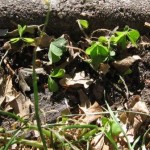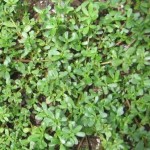Free Food!
ByAs some of you may know, I am also an Urban Forager and lead wild edible walks in the city neighborhoods. This is the time of year when all sorts of lovely spring greens are available for picking. Gathering the greens for dinner used to be considered part of the walk home from work, and included dandelions, dock, lambs quarters, and various flowers. Depending on the location, other herbs and ‘weeds’ were also available.
As kids we knew about eating the greens we found as we roamed. Slip the thin grass blades of timothy, wild oats, and rye grass from their stems and chew the ends to get some energy. Nibble on ‘sour grass’ or ‘pickle plant’ (Oxalis acetosa) for a lemony taste; use wild mint to add a good flavor to the mouth and aid the stomach. As time passed, we lost touch with the delicious goodness of these wild treats, somehow relegating them to a category of awful pests and weeds to be eliminated. I have a better suggestion: eat these nutritious little goodies after you pull them out of the garden!
One I am particularly fond of is purslane. It looks like a low-growing jade plant, spreading itself over the ground around the plants. I use it as a mulch to retain moisture on my sandy soil, and when there is too much nothing could be simpler to pull than this shallow rooted plant. It contains more omega 3 fatty acids than any other plant I’ve heard of, more than most fish, and can be used so many different ways: raw, sauteed, stewed, stir-fried, pickled, and if you have backyard chickens this is a great way to increase the omega 3 content in their eggs.
Many other cultures use purslane as a vegetable and sell it at the farmers market. I did find it in Ojai, CA at their farmers market! Maybe the local markets will have it soon along with dandelion greens and burdock roots. But why pay for these little goodies? They are there for the taking.
Just be aware and conscious of where you pick them! Make sure the area has not been sprayed with herbicide. You can tell if it has been sprayed if there is a mono-culture (only one type of plant), if the dandelions look stunted, strangely shaped, weirdly wilted, or there are those little flags present. Also, ASK! Don’t pick next to a busy street or thruway. Don’t pick where nothing much is growing, in old parking lots, or in industrial areas.
Also only use the wild edibles for less than half of a salad or cooked dish since they are generally much stronger than the veggies you buy at the store. They won’t hurt you but the idea is to enjoy them, not be overwhelmed by their exotic taste. These plants also will help you detoxify your body, and you want that to be gentle as well. Most of all, have a good time examining these tasty treats, add them to your diet slowly, learn your likes and dislikes, and NEVER eat any plant you do not know!! The library is a valuable resource and has many books on wild edibles. Now there are people like myself in most cities that will teach you about your sources and varieties of free food!



1 Comments
November 13th, 2012 at 1:12 PM
Hi Kate,
Is there such thing (here in Denver) as red purslane? I’ve lived in my house for 5 years and each year I get a green and red plant that looks like a mini jade plant growing in the yard. Is this a type of purslane and safe to eat?
Thanks,
Robyn